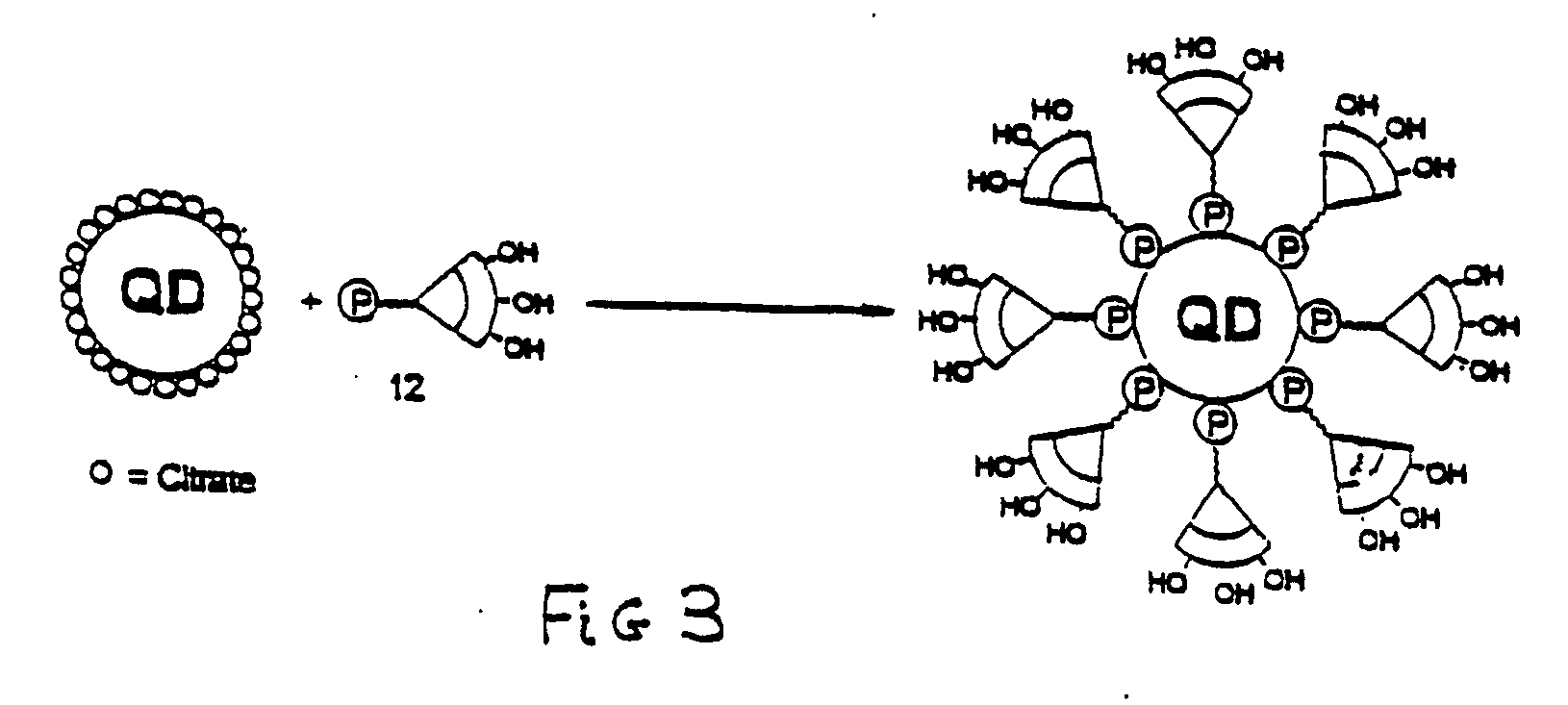Stabilized and chemically functionalized nanoparticles
a chemically functionalized, nanoparticle technology, applied in the field of dendronization of nanoscale surfaces, can solve the problems of inability to adapt to the tunable surface chemistry, the inability to stabilize the surface chemistry, and the inability to achieve the versatile introduction of tunable surface chemistry at bes
- Summary
- Abstract
- Description
- Claims
- Application Information
AI Technical Summary
Benefits of technology
Problems solved by technology
Method used
Image
Examples
example 1
[0061] There was provided a generation one, cystamine core, succinic acid surface dendrimer (59 mg, molecular weight of 2323, 0.0250 mmol) that was dissolved in DI water (0.5 ml.) that had been purged with nitrogen for 15 minutes. Then DTT (3.3 mg, 0.9 eq. / dendrimer) was added. The mixture was stirred at room temperature under nitrogen overnight (approximately 16 hours).
[0062] Three solutions were prepared: (1.) 0.2 M potassium carbonate using 2.764 gms. dissolved in 100 ml of DI water; (2.) 4% HAuCl4 using 82.1 mg of HAuCl4.3H2O dissolved in 1.70 ml. of DI water, and (3.) 0.5 mg / ml NaBH4 using 4.0 mg of NaBH4 dissolved in 8.0 ml of DI water.
[0063] One hundred ml of DI water was put into a 250 ml round-bottomed flask with a magnetic stirring bar. The flask was cooled to 0° C. with an ice-water bath. Five hundred microliters of the potassium carbonate solution and 375 microliters of gold solution was added and mixed well. Then 5 ml of the sodium borohydrate solution was added ml at...
example 2
[0065] (First Part)—With reference to FIG. 4, the hydroxyl in 1-methyl-4-(hydroxymethyl)-2,6,7-trioxabicyclo-{2.2.2}-octane (MHTBO 1), was protected with the benzyl group. Then the hydrolysis of the orthoester using a trace of concentrated hydrochloric acid in methanol exposes three hydroxyl groups to give compound 3. The tosylation of 3 gives compound 4 in high yields. Then, there are several problems. The attempt to react the tosylated product with alkoxide of 1 directly without being converted to abromide fails because of the steric hindrance. 2. During the purification of the product of the previous reaction, the orthoester was proved not stable to aqueous work up and partially hydrolyzed on silica gel. 3. The reaction of deprotecting the benzyl group is very slow probably because the steric hindrance of the other three bulky branches; and in the meantime, the orthoester can be cleaved partially during the catalytic hydrogenation.
[0066] (Second Part)—With reference to FIG. 5, p...
example 3
[0070] In 25 mL of anhydrous DMF was dissolved 1-methyl-4-(benzyloxymethyl)-2,6,7-trioxabicyclo-{2.2.2}-octane 2 HBO) 1 (5.0 g, 31.2 mmol)and was slowly added to a suspension of NaH (840 mg, 35 mmol; 1.4 g of 60% NaH dispensed in mineral oil and washed with hexane) in 25 Ml of DMF. The mixture was stirred for 45 min. then 4.1 Ml (5.9 g, 34.5 mmol) of benzyl bromide was added dropwise. Then the reaction was stirred at room temperature over night. Solvent was removed by rotary evaporation until 10 ml of DMF was left. The residue was slowly poured into 200 mL of DI water. A pale white solid precipitated out and was filtered to give 2 (6.64 g, 85.4%). This compound was used for the next step without further purification.
PUM
| Property | Measurement | Unit |
|---|---|---|
| Composition | aaaaa | aaaaa |
| Hydrophilicity | aaaaa | aaaaa |
| Semiconductor properties | aaaaa | aaaaa |
Abstract
Description
Claims
Application Information
 Login to View More
Login to View More - R&D
- Intellectual Property
- Life Sciences
- Materials
- Tech Scout
- Unparalleled Data Quality
- Higher Quality Content
- 60% Fewer Hallucinations
Browse by: Latest US Patents, China's latest patents, Technical Efficacy Thesaurus, Application Domain, Technology Topic, Popular Technical Reports.
© 2025 PatSnap. All rights reserved.Legal|Privacy policy|Modern Slavery Act Transparency Statement|Sitemap|About US| Contact US: help@patsnap.com



